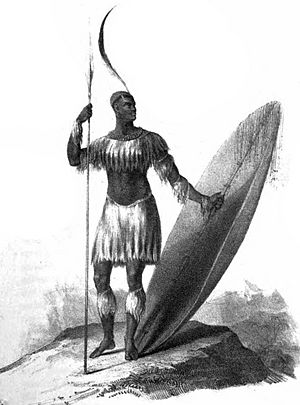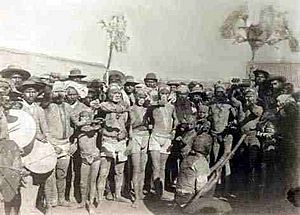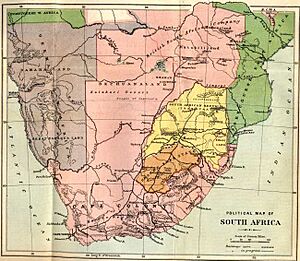History of South Africa (1815–1910) facts for kids
The history of South Africa between 1815 and 1910 is a time of big changes and conflicts. During the Napoleonic Wars, the Cape Colony became a British colony in 1815. Britain encouraged many people to move there, including the 1820 Settlers. These settlers were meant to farm in an area between the colony and the Xhosa people.
At the same time, Dutch farmers called the Boers felt left out by the British. In the 1820s, they began their Great Trek, moving north into new areas of South Africa. This period also saw the rise of the powerful Zulu people under their king, Shaka Zulu. Many fights broke out between the British, the Boers, and the Zulus. The Zulus were eventually defeated, and later, the Boers lost the Second Anglo-Boer War. However, the Treaty of Vereeniging helped create the Union of South Africa, giving the country some independence.
Contents
British Rule in South Africa
When the British took over the Cape Colony, they found a diverse population. There were about 25,000 slaves, 20,000 white colonists, 15,000 Khoisan people, and 1,000 freed black slaves. A small group of white people in Cape Town held most of the power.
The British first wanted the Cape Colony mainly for its important port location. They tried to solve a border problem between the Boers and the Xhosa people. In 1820, about 5,000 British immigrants were encouraged to settle between these groups. The idea was to create a safe zone. But this plan did not work well. Many of these 1820 Settlers soon moved to towns like Grahamstown and Port Elizabeth.
This arrival of British settlers changed South Africa. Before, the Boers were mostly unchallenged. Now, there were two main European language groups and cultures. English-speakers often lived in cities and controlled politics, trade, and mining. The Boers mostly stayed on their farms.
The differences grew when slavery was ended in 1833. The way slaves were freed also caused problems for the Boers. Even so, the British did not make many big social changes. In 1841, a law called the Masters and Servants Ordinance kept white people in control. More British people moved to Cape Town, the Eastern Cape, Natal, and later, the Transvaal after gold and diamonds were found.
The Difaqane and Big Changes
The early 1800s were a time of great change and conflict in Southern Africa. This was due to the growth of the Zulu kingdom. People who spoke Sotho called this time the difaqane, meaning "forced migration." Those who spoke Zulu called it the mfecane, meaning "crushing."
The main reason for the difaqane was the rise of the powerful Zulu kingdom. In the early 1800s, Nguni tribes in KwaZulu-Natal became a strong, military state. Shaka Zulu, a chief's son, was key to this change. He built large armies and led a huge expansion, conquering or enslaving those who resisted. His impis (warrior groups) were very disciplined. If they failed in battle, they faced death.
People in the path of Shaka's armies had to move. They then became attackers themselves against their neighbors. This wave of movement spread across Southern Africa. It also led to the creation of new states, like the Sotho kingdom (now Lesotho) and the Swazi kingdom (now Swaziland).
In 1828, Shaka was killed by his half-brothers, Dingaan and Umthlangana. Dingaan became king. He tried to work with British traders on the Natal coast. But soon, events would lead to the end of Zulu independence.
The Great Trek of the Boers
Meanwhile, the Boers in the Cape Colony were becoming very unhappy with British rule. Many things made them want to leave. Starting in 1835, groups of Boers, along with Khoikhoi and black servants, began to move into the interior. They were looking for more independence.
North and east of the Orange River, these Boers, called Voortrekkers ("Pioneers"), found huge areas of land that seemed empty. They thought they had found their promised land, with plenty of space for their cattle and their independent way of life. They did not know that the empty lands and scattered groups of people they saw were a result of the difaqane, not the normal state of affairs.
The Voortrekkers met little resistance from the scattered groups on the plains, except for the powerful Ndebele. The difaqane had spread these groups out, and they lacked horses and firearms. This made the Boers believe that European settlement was bringing civilization to a wild land. However, in the mountains where King Moshoeshoe I was building the Basotho nation (later Lesotho), and in the wooded valleys of Zululand, the Boers faced strong resistance. Their movements led to many fights and weak agreements over the next 50 years, as white control grew.
British, Boers, and Zulus: A Clash of Powers
The Great Trek first stopped at Thaba Nchu, near today's Bloemfontein. Here, the trekkers set up a republic. But disagreements among their leaders caused the Voortrekker groups to split. Some went north, but most crossed the Drakensberg mountains into Natal. They wanted to create a republic there.
Since the Zulus controlled this land, the Voortrekker leader Piet Retief visited King Dingaan. They made a deal for land in exchange for cattle that were supposedly stolen from the Zulus. However, after the cattle were returned, Dingaan ordered the killing of Retief and his unarmed Voortrekkers. This led to more Zulu attacks on the Boers, and then revenge attacks by the Boers. The biggest fight was on 16 December 1838, at the Battle of Blood River in Natal. The Boers, though greatly outnumbered (464 Boers against an estimated 30,000 Zulus), won without losing a single man.
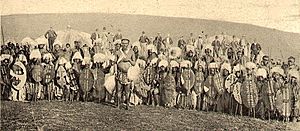
Despite this victory, the Boers' hope for a Natal republic was short-lived. The British took over the area in 1843 and started their new Natal colony at present-day Durban. The British wanted to grow sugar on large farms in Natal. But few Zulu people wanted to work as laborers. The British faced strong resistance from the Zulus, who had a long history of warfare. In 1879, the Zulus gave the British army a big defeat at the Battle of Isandlwana, killing over 1,400 British soldiers. During the ongoing Anglo-Zulu Wars, the British eventually gained control over what was then called Zululand, now KwaZulu-Natal.
To solve their labor shortage, the British brought workers from India. Zulu men did not want to work in the way the British wanted. In 1860, the SS Truro arrived in Durban with over 300 people. Over the next 50 years, 150,000 more indentured (contracted) Indians arrived, along with many free "passenger Indians." This created the largest Indian community outside of India. By 1893, when Mahatma Gandhi arrived in Durban, there were more Indians than white people in Natal.
Independent South Africa Begins to Grow
The Boer Republics Form
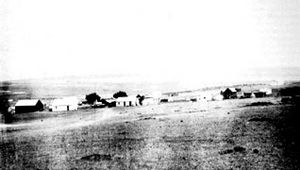
The Boers continued their search for land and freedom. They eventually set up their own areas, called Boer Republics, like the Transvaal and the Orange Free State. For a while, it seemed these republics would become stable states, even though they had few people, no industry, and little farming.
But then, diamonds were discovered near Kimberley in 1869. This changed everything for the Boers. The first diamonds were found on land claimed by both the Transvaal and the Orange Free State. Britain quickly stepped in and took the area for itself.
The discovery of the Kimberley diamond mines brought many European and black workers to the area. Towns grew quickly, where people did not follow the usual separation of whites and blacks. The Boers were angry that their poor republics had missed out on the wealth from the mines.
The Anglo-Boer Wars
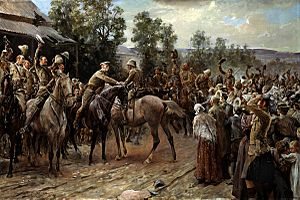

First Anglo-Boer War
The Boers' long-standing anger turned into a rebellion in the Transvaal, which had been under British control since 1877. The first Anglo-Boer War, which Afrikaners called the "War of Independence," began in 1880. It ended quickly with a big Boer victory at Battle of Majuba Hill on 27 February 1881. The republic got its independence back as the Zuid-Afrikaansche Republiek ("South African Republic"), or ZAR. Paul Kruger, one of the leaders, became President of the ZAR in 1883. The British, who saw their defeat as a mistake, still wanted to unite the Southern African colonies and republics. They thought this was the best way to deal with the large number of Afrikaners and to protect their own interests.
Between the Wars
In 1879, Zululand came under British control. Then, in 1886, an Australian explorer found gold in the Witwatersrand. This sped up the process of uniting the colonies and was another blow to the Boers. Johannesburg's population grew very fast to about 100,000 by the mid-1890s. The ZAR suddenly had thousands of uitlanders (outsiders), both black and white. The Boers felt pushed aside. The arrival of English miners especially worried the Boers, many of whom disliked them.
The huge wealth from the mines became very tempting for British imperialists. In 1895, a group led by Captain Leander Starr Jameson entered the ZAR. They wanted to start an uprising in the Witwatersrand and put a British government in charge. This event was called the Jameson Raid. The plan failed, but it seemed clear to Kruger that the Cape Colony government had at least quietly approved it. He knew his republic was in danger. So, he formed an alliance with the Orange Free State.
Second Anglo-Boer War
The situation became very tense in 1899, leading to the Second Anglo-Boer War. The British could not defeat the Boers with normal war methods. So, they used harsh tactics, including burning farms and capturing hundreds of thousands of Boer women and children, and many native people, in concentration camps. By 1902, 26,000 Boers (mostly women and children) had died in these camps from disease, hunger, and neglect. A British humanitarian, Emily Hobhouse, wrote about the terrible conditions.
On 31 May 1902, a peace treaty was signed, called the Treaty of Vereeniging. Under this treaty, the Boer republics accepted British rule. In return, the British promised to rebuild the areas they controlled.
The Path to Union
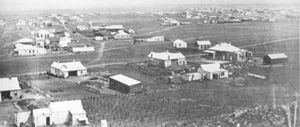
After the war, the British focused on rebuilding the country, especially the mining industry. By 1907, the mines in the Witwatersrand produced almost one-third of the world's gold each year. But the peace was still fragile. The Afrikaners felt like poor farmers in a country where big mining companies and foreign money made them feel unimportant. The British tried to make them speak English and use it in schools and at work, which made them very angry. Because of this, the Boers began to see Afrikaans as their "people's language" (volkstaal) and a symbol of their nation. Several nationalist groups were formed.
Black and Coloured people remained left out of society. After many talks with the Boers, a form of "segregation" was put in place. Unpopular taxes were introduced. The British administrator also encouraged thousands of Chinese workers to come, which lowered wages for others. Anger exploded in the Bambatha Rebellion of 1906. In this rebellion, 4,000 Zulus died after protesting harsh tax laws.
Meanwhile, the British continued their plans for a union. After several years of talks, the South Africa Act 1909 brought the colonies and republics together. These were the Cape Colony, Natal, Transvaal, and Orange Free State. They became the Union of South Africa. Under this act, the Union was still British territory, but Afrikaners had home-rule (they could govern themselves). The British territories of Basutoland (now Lesotho), Bechuanaland (now Botswana), Swaziland, and Rhodesia (now Zambia and Zimbabwe) remained under direct British rule.
English and Dutch became the official languages. Afrikaans was not recognized as an official language until 1925. Even after a big campaign by Black and Coloured people, only white people could vote or be elected to Parliament.
The Union of South Africa in 1910
In 1910, the Union of South Africa was formed. It brought together four areas: the two former independent Boer republics (the South African Republic and the Orange Free State) and the British-controlled Cape Province and Natal. The new Union of South Africa gained international respect as a British Dominion. This put it on the same level as other important British dominions and allies like Canada, Australia, and New Zealand.
|


